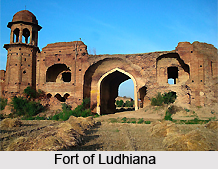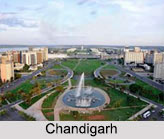 The history of Ludhiana goes back a long way to 1481 when it was merely a small village called Meer Hota. This village was initially ruled by Yodhas from the 1st to the 4th century, it consequently came under King Samudragupta and the Rajputs .The original people of Ludhiana settled there much later in the 9th century.
The history of Ludhiana goes back a long way to 1481 when it was merely a small village called Meer Hota. This village was initially ruled by Yodhas from the 1st to the 4th century, it consequently came under King Samudragupta and the Rajputs .The original people of Ludhiana settled there much later in the 9th century.
Formation of Ludhiana
During the reign of Sikandar, son of Bahlul Lodi, the people of Ludhiana were exploited by the plundering Baluchis, and applied to the Emperor for aid. Sikandar, in answer to their prayer, sent two of his Lodi chiefs, by name Yusaf Khan and Nihang Khan, with an army. These chiefs selected the present site of the Ludhiana city and Nihang Khan remained at Meer Hota as the Emperor`s Lieutenant; and he called the place Ludhiana. His grandson succeeded him.
Ludhiana"s Attachment to Sirhind
Later Jalal Khan built the fort of Ludhiana and his two sons partitioned the country round about Ludhiana, which was then lying in abandonment, amongst the people of the town, and distributed them in villages. In the time of Jalal Khan`s grandsons, Alu Khan and Khizr Khan, Babar overthrew the Lodi dynasty; and the Lodis of Ludhiana were demoted to the position of ordinary subjects of the Mughal Empire. They were said to live close to the fort for many generations, but all of their connections have now disappeared. The Lodi dynasty lost control of the throne of Delhi in 1526. The Mughals thus established a strong government at Sirhind, which itself was a sarkar (division) of the Delhi subah (province), and attached Ludhiana as a mahal or parganah. The history of Ludhiana thus entered its second phase.
Decline of Mughal Empire
Following the death of Akbar in 1605, Ludhiana was dominated by the rise of Sikhism as a power, and the decline of the Mughal Empire. By this time, the Mughal Empire was coming to an edge, and various local powers began to declare their independence. The Rais of Raikot who until then had held a considerable tract of land around Ludhiana in lease from the emperors, were some of the first to assert their independence. Raja Ala Singh of Patiala, the representative of the crumbling Delhi Sultanate and Rai Kalha II were the principal contenders for power in the region.
After the gradual fall of Sirhind, the last vestige of Mughal controlled over the area, and Ludhiana was surrendered to the Rais. The Malaudh Sirdars belonging to the Phulkian stock had already established themselves in the south of Ludhiana in the Jangal villages.
 Bedi"s Attack on Ludhiana
Bedi"s Attack on Ludhiana
Around 1785, the Sutlej River changed in course and then Ludhiana was no longer situated on its banks. In 1798, history of Ludhiana saw the ferocious attack by the Sikhs under Bedi Sahib Singh of Una. Then the ruler of the Rais, Rai Alias and his agents Roshan and Gujar made a good stand against the Sikhs at Jodh, which was ten miles (16 km) southwest of Ludhiana. Roshan was killed in that war, and Rai`s army was dispersed.
However, the Phulkian chiefs, who were on good terms with the Rais did not intend to allow the Bedi to establish himself in their midst and came to their assistance, driving the invaders out of the villages. Upon Bedi`s blockade of Ludhiana, the Rais called in British mercenary George Thomas to help with the protection of the city. On Thomas`s approach, Bedi returned to the other side of the Sutlej River.
Ranjit Singh"s Attack on Ludhiana
After consolidating with the new Sikh Empire, Maharaja Ranjit Singh crossed the Sutlej in 1806 in his first expedition against the Cis-Sutlej states and exposed the Rais of all their possessions, including Ludhiana. Then the city was occupied but not annexed to the Lahore state. By 1809, Ranjit Singh brought a change in the history of Ludhiana by completing his third expedition on the west bank of the Sutlej; then he was ready to attack Ludhiana.
British Cantonment in Ludhiana
Fearing further development that was coming closer to their headquarters in Delhi, British imperialist forces occupied the Cis-Sutlej states that were on the east of the river. The British sent Colonel David Ochterlony with a force to annex Ludhiana. However, by the end of 1809, the Treaty with the Rajah of Lahore was signed in, on which the Rajah agreed to remain in the north and west of the Sutlej. British troops were permanently stopped in Ludhiana, and they established a cantonment to further merge their occupation.
Abolishment of British Cantonment from Ludhiana
The British paid compensation to the Raja of Jind. In 1835, the Jind family, who technically was still ruling Ludhiana, was left without any heirs. So, by the British doctrine of lapse, Ludhiana came under the authorized control of the imperialists. After the First Afghan War, Ludhiana became the home of the exiled family of Shah Shuja. The British cantonment was then abandoned in 1854.
The history of Ludhiana narrates many tales of heroism and gallantry and thus the prestigious north Indian city of Ludhiana was formed.



















